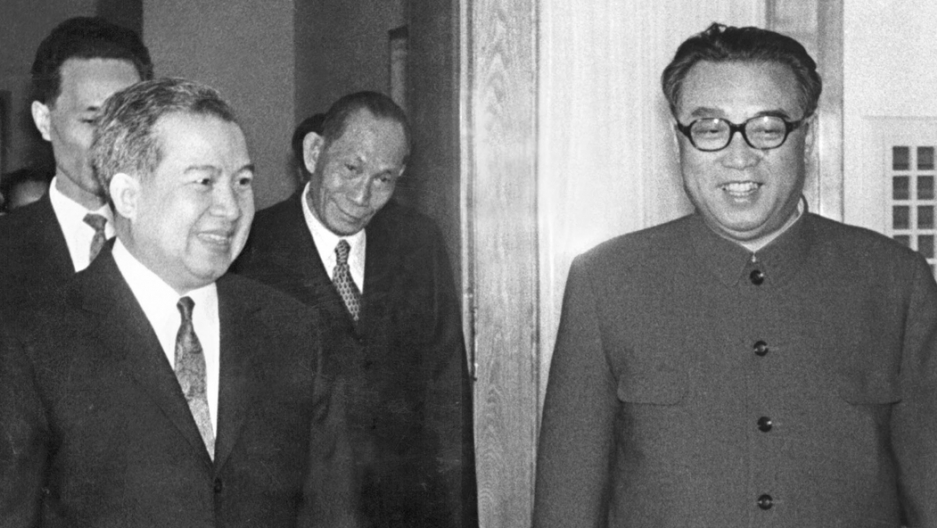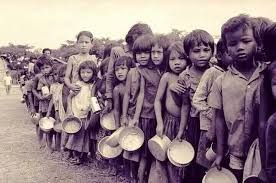The Khmer Rouge and North Korea had a relationship that was extremely complex. Technically they were ideologically aligned, but as opposed to China friendships and personal relations took precedence over geopolitical issues.
With that being said though the Democratic Peoples Republic of Korea (DPRK) remained an ally of the Khmer Rouge from before the revolution, to its time covering as Democratic Kampuchea, through to its time in opposition to the People’s Republic of Kampuchea.
Table of Contents
Kim Il-Sung and the King Sihanouk
No conversation about Cambodia and the Khmer Rouge can happen without discussing the relationship between President Kim-Il-Sing of the DPRK and then head of state Sihanouk. They had initially became friends after being introduced at a meeting of the Non-Aligned Movement and indeed become friends.
Said friendship was so close that Sihanouk called President Kim his “closest friend after the death of my mother”. Said friendship led to a number of slightly strange actions, such as Cambodia hosting the DPRK in a football match against Australia to decide who went to the 1966 World Cup.

Sihanouk and the socialist block
As well as his friendship with North Korea Sihanouk has also made numerous other friends within the socialist block, such as North Vietnam, Indonesia and most importantly China.
China much like the DPRK and Vietnam considered a Sihanouk ran Cambodia as such a worthy ally that it outranked ideology. Cambodia for its part though allowed Communist within the government, as well as playing at least lip service to the left through “Buddhist Socialism”.
It was here though that the politics of Cambodia and the region did become more complicated, because whilst Cambodia and North Vietnam were officially allies of Sihanouk, both played a role in helping the Khmer Rouge.
This was most paramount from the Chinese side, who helped morph the Poles Revolutionary Party of Kampuchea into the Workers Party and finally the Communist Party of Kampuchea, all the while along Maoist lines. During this period senior members of the Cercle Marxiste also visited the Peoples Republic of China, where they were not just welcomed with open arms, but received money and training.
Yet while the party also received support from the Soviet Union, it was only ever enough to keep it active, rather than actually having any chance of overthrowing Sihanouk. This though would all change in 1970.
The 1970 coup and Khmer Rouge – North Korea relations
Relations between the Khmer Rouge and North Korea, as well as with China, the Soviet Union and the wider western block would change drastically in 1970. During this year Lon Nol alongside the Khmer Bleu and supported by the CIA would overthrow Sihanouk.
This created the perfect storm whereby China et all could support both Sihanouk and the Khmer Rouge in a coalition against the US backed Khmer Republic.
Called the GRUNK (The Royal Government of the National Union of Cambodia) to fight against the Khmer Republic with communist forces bolstered by people wanting to fight for their King, as Sihanouk bounced between Pyongyang and Beijing.
This alliance would eventually topple the Khmer Republic taking over Phnom Penh on April 17th 1975, when the coalition “Royal Government” took over.
Sihanouk became head of state of what was technically a “Royal Government” until the founding of Democratic Kampuchea. At this point he would resign his position to be replaced as head of state by Khieu Samphan.
For the remaining years if their rule he would remain under house arrest in the Royal Palace, During this time killing Sihanouk was indeed discussed, but for whatever reason did not happen. Many have opined that it was pressure from both China, as well as North Korea that saved him.
During this period North Korea was one of the few nations to keep an embassy in Phnom Penh and they were known to make comments in support of Pol Pot. Yet despite this and as later statements and actions would show, their loyalty was with Sihanouk, rather than the Khmer Rouge.
To read about the Khmer Rouge and the Soviet Union click here.
North Korea and the Khmer Rouge insurrection
In 1979 a group of Cambodian socialists backed up the Soviet aligned Vietnam overthrew the China backed Democratic Kampuchea. This led to the Khmer Rouge again going underground and to the somewhat perverse situation of a communist republic, namely the Peoples Republic of Kampuchea fighting against a communist insurgency from the Khmer Rouge.
During this period clear battle lines were drawn, with the Eastern Block fronted by Vietnam and the USSR supporting the new government. On the other hand the west supported the opposition in keeping the seat on the United Nations, namely the Khmer Rouge, who had once again formed an unholy alliance with Sihanouk and others against the “Vietnamese puppets”.
Through the support of the Chinese the west could duly look away while they bankrolled and trained the Khmer Rouge in the insurgency right up until the early 1990’s. The Americans could thus fund non-existent “democratic forces”, while others did the dirty work. This is of course has since been seen in Syria.
This in some respects put North Korea in a tight position. Technically they had taken no side in the Sino-Soviet split and for all intents had no real love for the Khmer Rouge. They did though have love for Sihanouk, which meant they were to support him, which meant supporting the GGGG, and thus opposing the Soviet Union.
The reasoning for this can best be summarized by the following quote from Comrade Kim Il-Sung, when he stated “our Communism is not honourable unless it supports the patriots like Sihanouk, who struggle for the independence of their country and his people’s freedom. Communism would lose much of its value if it did not respect the patriotism and ideals of independence and freedom of others”.
A point further emphasized when he simply said “The Khmer Rouge embassy is here, but I support Prince Sihanouk”.
The Khmer Rouge and North Korea after 1991
Fowling 1991 and the initial return of Sihanouk, first as head of state and then as king of the Kingdom of Cambodia, support from the DPRK to the Khmer Rouge became non-existent.
And not just this, but support and friendship with Sihanouk actually grew in the following years. This was to such a degree that not only did Sihanouk have a palace in Pyongyang up until his death, but was also protected by North Korean bodyguards for the rest of his life.
Aside from trade North Korea then largely remained silent as the Khmer Rouge moved into their last state, and Cambodia through Hun Sen and the Cambodian Peoples Party moved even further from any vestiges of communism.
Diplomatic relations though remain between the states, with Cambodia being one of thew few nations to still host and embassy of the DPRK.




